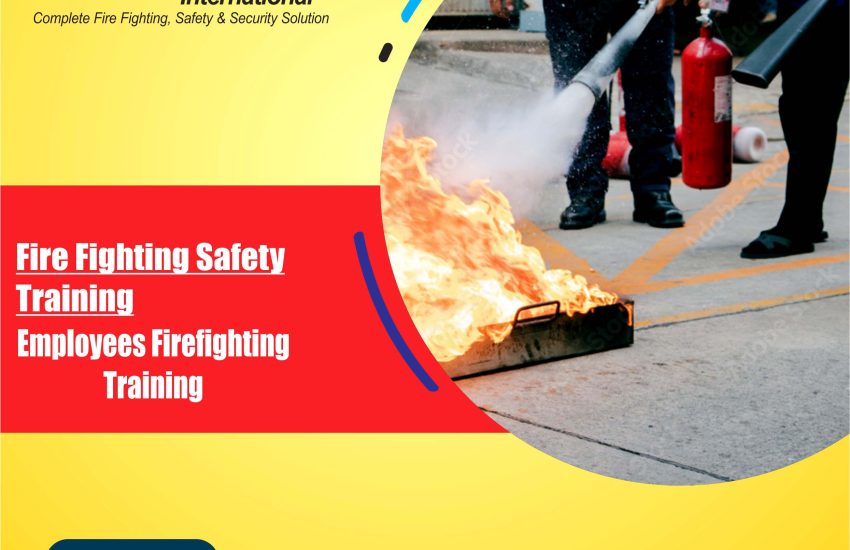Employees Firefighting Training Fire safety is one of the most critical aspects of workplace safety, and employees firefighting training is an essential part of any comprehensive fire safety plan. Proper training equips employees with the knowledge and skills to handle fire emergencies, minimizing damage to property and ensuring the safety of everyone in the building. This article will outline the importance of firefighting training, its key components, and how it can help create a safer work environment.
Why is Employees Firefighting Training Important?
In a fire emergency, every second counts. Employees must be prepared to react swiftly and appropriately to reduce the risk of injury and damage. Employees firefighting training is crucial because:
- It empowers employees with the knowledge and skills to take immediate action in the event of a fire.
- It can help contain small fires before they escalate into larger, uncontrollable ones.
- It fosters a culture of safety within the workplace, ensuring that fire safety is taken seriously.
- It complies with fire safety regulations, ensuring the company meets legal requirements for employee training.
In essence, firefighting training for employees is not only about ensuring legal compliance but also about protecting lives, preventing property damage, and maintaining business continuity.
Key Components of Employees Firefighting Training
1. Fire Prevention and Hazard Identification
The first step in any firefighting training program is teaching employees how to prevent fires and identify potential fire hazards. Employees should be able to:
- Recognize common fire hazards in the workplace, such as electrical faults, flammable materials, and blocked fire exits.
- Implement basic fire prevention strategies like maintaining equipment, storing materials properly, and keeping fire exits clear.
- Understand the importance of fire safety policies and adhering to safety guidelines.
Fire prevention is the first line of defense in fire safety, and employees should be educated on how their daily actions can either prevent or cause a fire.
2. Understanding Fire Classifications and Fire Extinguishers
An essential part of firefighting training is understanding the different types of fires and how to extinguish them. Fires are categorized into different classes based on the materials involved:
- Class A: Ordinary combustibles like wood, paper, and cloth.
- Class B: Flammable liquids like gasoline, oil, and paints.
- Class C: Electrical fires.
- Class D: Combustible metals.
- Class K: Cooking oils and fats.
Employees should be familiar with these classifications and know which type of fire extinguisher is suitable for each type of fire. The training should cover:
- The correct operation of fire extinguishers (using the PASS technique: Pull, Aim, Squeeze, Sweep).
- The proper use of other firefighting equipment, such as fire blankets or fire hoses.
- The importance of checking and maintaining fire extinguishers regularly.
3. Evacuation Procedures and Emergency Response
In the event of a fire, evacuating the building quickly and safely is paramount. Employees should be well-versed in the fire evacuation plan and understand their roles in the process. Training should include:
- Evacuation routes: Employees should know the safest exit routes and alternative exits if the primary routes are blocked.
- Assembly points: Designated areas where employees should gather after evacuating the building to ensure everyone is accounted for.
- Fire alarm procedures: Understanding how to trigger the fire alarm and what actions to take when it sounds.
- Special needs evacuation: Employees should know how to assist individuals with disabilities or those who need help evacuating.
Regular fire drills are essential to ensure that employees are familiar with these procedures and can evacuate the building swiftly in the event of a real fire emergency.
4. Dealing with Fire Emergencies
Firefighting training also prepares employees to act in a fire emergency. They should understand:
- When it is safe to fight a fire and when to evacuate (i.e., if the fire is small, contained, and manageable).
- How to assess the situation and decide whether to use firefighting equipment or leave the area immediately.
- How to remain calm and avoid panic, ensuring that everyone follows the evacuation plan without confusion or delay.
Training employees to remain level-headed and act decisively during a fire can prevent accidents and ensure a more effective response to the emergency.
5. Post-Fire Recovery and Reporting
Once a fire is extinguished, there are important steps employees must take during the post-fire recovery phase:
- Reporting the incident: Employees must be trained on how to report the fire to the appropriate authorities or management and ensure that the fire department conducts an investigation if necessary.
- Assessing the damage: Employees should understand the importance of documenting the damage caused by the fire and reporting it to the insurance company.
- Revisiting the fire safety plan: After a fire, it’s essential to evaluate the effectiveness of the firefighting response and update the fire safety plan based on any lessons learned.
Best Practices for Employees Firefighting Training
- Hands-on training: Practical, hands-on training sessions ensure that employees are comfortable using fire extinguishers and other firefighting equipment.
- Regular refresher courses: Firefighting training should be updated regularly to keep employees informed of the latest fire safety techniques and technologies.
- Clear fire safety policies: Employers should have clear, easy-to-understand fire safety policies that employees can reference at any time.
- Documenting training: Employers should keep detailed records of training sessions and employee certifications to ensure compliance with safety regulations.
Conclusion
Employees Firefighting Training is a critical component of any organization’s overall fire safety program. By training employees to identify fire hazards, use firefighting equipment properly, follow evacuation procedures, and remain calm during an emergency, businesses can significantly reduce the risk of fire-related injuries and damage. A well-trained workforce is a key asset in ensuring workplace safety and compliance with fire safety regulations.


